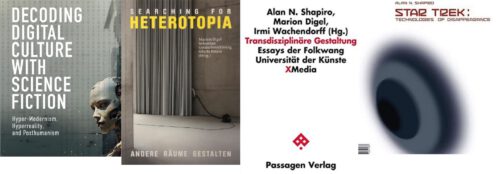
Alan N. Shapiro
media theory,
science fiction theory,
future design research



-
Comments About “Venice in Las Vegas”
Here I will post comments about “Venice in Las Vegas” as they come in.
-
Two Keynote Lectures in Turkey
On October 31, 2025, I was a keynote speaker at the conference on “Media and Communication” at the University of Sakarya, Turkey. On November 4, 2025, I was a keynote speaker at the conference on Turkish cinema at the same university.
-
Venice in Las Vegas
My memoir book “Venice in Las Vegas: An American and European Auto-Socio-Biography, 1960s to 1980s” has been published in the Counterpoints Studies in Criticality series, edited by Shirley Steinberg, of the Peter Lang Publishing House.
-
Alan N. Shapiro racconta “Star Trek” (RAI4 Italian TV interview)
This is the transcript of an interview about Star Trek which I did on Italian TV (RAI4) in 2013. There exist also transcripts of interviews which I did on Italian TV about Lost and The Prisoner.
-
Science Fiction Research Association (SFRA) Election
I am currently a candidate for President of the Science Fiction Research Association (SFRA). Anyone who wishes to discuss my candidacy with me is encouraged to contact me to engage in dialogue. You can write me an e-mail.
-
Four Reviews of “Decoding Digital Culture with Science Fiction”
Here are short excerpts from four reviews of my book “Decoding Digital Culture with Science Fiction: Hyper-Modernism, Hyperreality, and Post-Humanism,” and some other quotations about the book.
-
Ayesha Mubarak Ali Podcast About My Book
This is a transcript of Ayesha Mubarki AIi’s podcast about “Decoding Digital Culture with Science Fiction” that was part of her “Human Reimagined” series, January 2025.
-
Reply to a Critical Review of My Book
In his review of my book Decoding Digital Culture with Science Fiction: Hyper-Modernism, Hyperreality, and Posthumanism in the journal Science Fiction Studies (July 2025), Miguel Sebastián-Martín makes many disparaging claims that are factually incorrect.
-
Reviews of Star Trek: Technologies of Disappearance
Here are excerpts from three reviews of my book “Star Trek: Technologies of Disappearance,” beginning with the long review-essay in Science Fiction Studies, and some other quotations about the book.
-
Prominente: Groß und Klein
Die Amerikaner träumen groß. Die größten Hamburger. Die größten Hot Dogs. Zum Mond und Mars. Der Football Super Bowl und die Baseball World Series. Die größten Prominenten. Marilyn Monroe, Elvis Presley, Michael Jackson, Madonna. Sie waren groß. Sie waren die Stars. Das waren die Prominente im Zeitalter der Massenmedien.
-
Donna J. Haraway’s “A Manifesto for Cyborgs”
Donna Haraway’s text “A Manifesto for Cyborgs” was written in 1985, but it reads as if itwere written yesterday. A cyborg is a hybrid of living organism and machine. The cyborg is a person whose body has been supplemented by artificial components. The term is anacronym derived from “cybernetic organism.”
-
Star Trek: Technologies of Disappearance, by Alan N. Shapiro
Does Star Trek’s worldview coincide with the unbridled high-tech enthusiasm of recent years? Or is there a tension between the show’s originality and the Borg-like assimilation of its creativity by the Star Trek industry? Focusing on the stories themselves, the author reveals the basic principles behind Star Trek that contest the ideology of mainstream technoscience.
-
Methodology – Thirty Minute Statement at my Ph.D. Oral Defense
I will begin with some autobiographical remarks. I have a double educational background in the humanities and natural sciences. I studied the former at Cornell University and the latter at the Massachusetts Institute of Technology. Later in life, I worked for twenty years as a software developer. I had earlier studied literature and philosophy.
-
Blade Runner 2049: Android Liberation Between Old and New Informatic Power
Blade Runner 2049 is a brilliant sequel to the original Blade Runner. Thirty years after the events of the first film, the police discover evidence of the secret that Rachael, who was a replicant or android, became pregnant and gave birth in a “natural” fertility process to a child. Rachael died while achieving childbirth.
Categories
